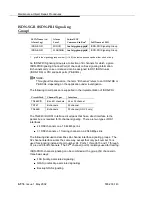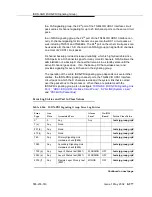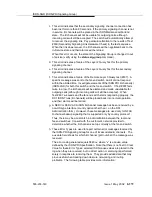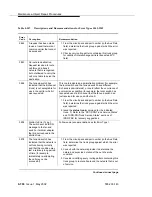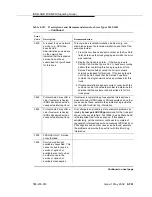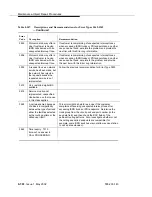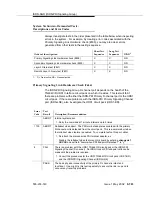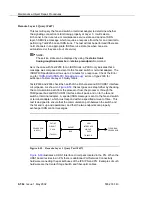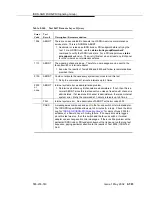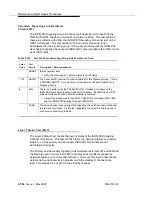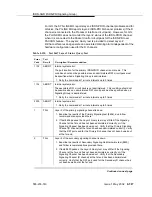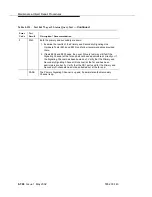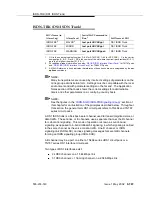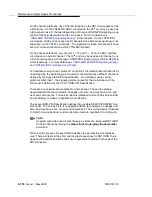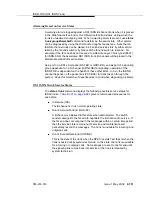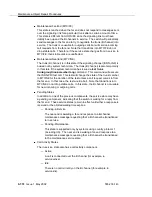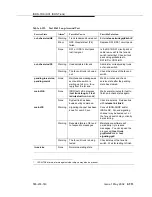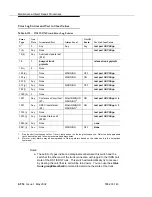
Maintenance-Object Repair Procedures
555-233-143
8-990
Issue 1 May 2002
On 24-channel interfaces, any of the first 23 ports on the DS1 circuit packs can be
a B channel. On the TN464C/D UDS1 circuit pack, the 24
th
port may be used as
a B channel or as a D channel depending on the type of ISDN-PRI signaling group
(FAS or NFAS) implemented on the circuit pack. For more details, see
‘‘ISDN-SGR (ISDN-PRI Signaling Group)’’
in this chapter. On the TN767 DS1
circuit pack, all 24 ports are used as B channels since D-channel signaling is not
supported on the TN767 circuit pack. The signaling for these B channels is done
over a D channel located on a UDS1 TN464C/D board.
On 32-channel interfaces, any of ports 1 – 15 and 17 – 31 on the DS1 interface
circuit pack can be a B channel. The 16
th
port may be used as a B channel or as
a D channel depending on the type of ISDN-PRI signaling group (FAS or NFAS) to
which it belongs. For more details, see
‘‘ISDN-SGR (ISDN-PRI Signaling Group)’’
and
‘‘DS1-BD (DS1 Interface Circuit Pack)’’
For interfaces using country protocol 1 on the DS1 circuit pack administration form
(including US), the signaling protocol used for the maintenance of the B channel is
defined by the Avaya ISDN-PRI specification. For interfaces using country
protocols other than 1, the signaling protocol used for the maintenance of the
B channel is defined by the CCITT ISDN-PRI Specification.
There are five possible service states for a B channel. The service state is
negotiated with the far-end switch, changes over time, and may have a far- and
near-end components. The service state is initialized to Out-of-Service/Far-End,
and an attempt is made to negotiate it to In-Service.
The Avaya ISDN-PRI Specification defines the possible SERVICE STATES for a
B channel. The service state is negotiated with the far-end switch, changes over
time, and may have a far- or near-end component. The service state is initialized
to Out-Of-Service/Far-End, and an attempt is made to negotiate it to In-Service.
NOTE:
A system technician can display the service state of a particular DS1 ISDN
Trunk B channel by issuing the status trunk trunk-group/trunk member
command.
When a call is present, the specification defines the permissible call states as
well. There are tests in the short and long test sequences for DS1 ISDN Trunk
designed to audit these states and ensure agreement between both ends of the
PRI connection.
Summary of Contents for S8700 Series
Page 50: ...Maintenance Architecture 555 233 143 1 26 Issue 1 May 2002 ...
Page 74: ...Initialization and Recovery 555 233 143 3 12 Issue 1 May 2002 ...
Page 186: ...Alarms Errors and Troubleshooting 555 233 143 4 112 Issue 1 May 2002 ...
Page 232: ...Additional Maintenance Procedures 555 233 143 5 46 Issue 1 May 2002 ...
Page 635: ...status psa Issue 1 May 2002 7 379 555 233 143 status psa See status tti on page 7 406 ...
Page 722: ...Maintenance Commands 555 233 143 7 466 Issue 1 May 2002 ...

